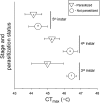Upper thermal limits differ among and within component species in a tritrophic host-parasitoid-hyperparasitoid system
- PMID: 29894508
- PMCID: PMC5997305
- DOI: 10.1371/journal.pone.0198803
Upper thermal limits differ among and within component species in a tritrophic host-parasitoid-hyperparasitoid system
Abstract
Understanding how climate change affects host-parasite systems and predicting the consequences for ecosystems, economies, and human health has emerged as an important task for science and society. Some basic insight into this complex problem can be gained by comparing the thermal physiology of interacting host and parasite species. In this study, we compared upper thermal tolerance among three component species in a natural host-parasitoid-hyperparasitoid system from Virginia, USA. To assess the ecological relevance of our results, we also examined a record of maximum daily air temperatures collected near the study site in the last 124 years. We found that the caterpillar host Manduca sexta had a critical thermal maximum (CTmax) about 4°C higher than the parasitic wasp, Cotesia congregata, and the hyperparasitic wasp, Conura sp., had a CTmax about 6°C higher than its host, C. congregata. We also found significant differences in CTmax among instars and between parasitized and non-parasitized M. sexta. The highest maximum daily air temperature recorded near the study in the last 124 years was 42°C, which equals the average CTmax of one species (C. congregata) but is several degrees lower than the average CTmax of the other two species (M. sexta, Conura sp.) in this study. Our results combined with other studies suggest that significant differences in thermal performance within and among interacting host and parasite species are common in nature and that climate change may be largely disruptive to these systems with responses that are highly variable and complex.
Conflict of interest statement
The authors have declared that no competing interests exist.
Figures



Similar articles
-
The lack of plasticity and interspecific variability in thermal limits produce a highly heat-tolerant tropical host-parasitoid system.J Therm Biol. 2024 Jul;123:103930. doi: 10.1016/j.jtherbio.2024.103930. Epub 2024 Aug 5. J Therm Biol. 2024. PMID: 39116624
-
Transcriptomic response of Manduca sexta immune tissues to parasitization by the bracovirus associated wasp Cotesia congregata.Insect Biochem Mol Biol. 2015 Jul;62:86-99. doi: 10.1016/j.ibmb.2014.12.008. Epub 2015 Jan 10. Insect Biochem Mol Biol. 2015. PMID: 25584519
-
Host nutrition determines blood nutrient composition and mediates parasite developmental success: Manduca sexta L. parasitized by Cotesia congregata (Say).J Exp Biol. 2005 Feb;208(Pt 4):625-35. doi: 10.1242/jeb.01403. J Exp Biol. 2005. PMID: 15695755
-
Parasitization of Manduca sexta larvae by the parasitoid wasp Cotesia congregata induces an impaired host immune response.J Insect Physiol. 2005 May;51(5):505-12. doi: 10.1016/j.jinsphys.2004.11.019. J Insect Physiol. 2005. PMID: 15893997
-
Host species differences in the thermal mismatch of host-parasitoid interactions.J Exp Biol. 2023 Jun 15;226(12):jeb245702. doi: 10.1242/jeb.245702. Epub 2023 Jun 27. J Exp Biol. 2023. PMID: 37338185 Free PMC article.
Cited by
-
Timing of extreme heat events matters: exposure during parasitism disrupts top-down control.Oecologia. 2025 Aug 12;207(9):141. doi: 10.1007/s00442-025-05781-6. Oecologia. 2025. PMID: 40794330 Free PMC article.
-
Climate Change, Extreme Temperatures and Sex-Related Responses in Spiders.Biology (Basel). 2023 Apr 18;12(4):615. doi: 10.3390/biology12040615. Biology (Basel). 2023. PMID: 37106814 Free PMC article. Review.
-
Implications of increasing temperature stress for predatory biocontrol of vector mosquitoes.Parasit Vectors. 2020 Dec 1;13(1):604. doi: 10.1186/s13071-020-04479-3. Parasit Vectors. 2020. PMID: 33261665 Free PMC article.
-
Climate change-mediated temperature extremes and insects: From outbreaks to breakdowns.Glob Chang Biol. 2020 Dec;26(12):6685-6701. doi: 10.1111/gcb.15377. Epub 2020 Oct 16. Glob Chang Biol. 2020. PMID: 33006246 Free PMC article. Review.
-
Contrasting effects of climate warming on hosts and parasitoids: insights from Rocky Mountain aspen leaf miners and their parasitoids.Proc Biol Sci. 2025 Mar;292(2043):20242679. doi: 10.1098/rspb.2024.2679. Epub 2025 Mar 26. Proc Biol Sci. 2025. PMID: 40132629 Free PMC article.
References
-
- Harrington R, Woiwood I, Sparks T. Climate change and trophic interactions. Trends Ecol Evol. 1999; 14: 146–150. - PubMed
-
- Epstein PR. Climate change and emerging infectious diseases. Microb Infect. 2001; 3: 747–754. - PubMed
-
- Thomas MB, Blanford S. Thermal biology in insect-parasite interactions. Trends Ecol Evol. 2003; 18: 344–350.
-
- Hoover JA, Newman JA. Tritrophic interactions in the context of climate change: a model of grasses, cereal Aphids and their parasitoids. Glob Change Biol. 2004; 10: 1197–1208.
-
- Brooks DR, Hoberg EP. How will global climate change affect parasite-host assemblages? Trends Parasitol. 2007; 23: 571–574. doi: 10.1016/j.pt.2007.08.016 - DOI - PubMed
Publication types
MeSH terms
LinkOut - more resources
Full Text Sources
Other Literature Sources

